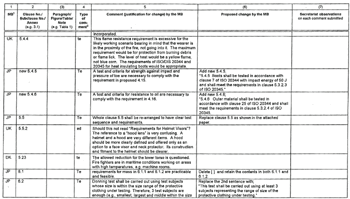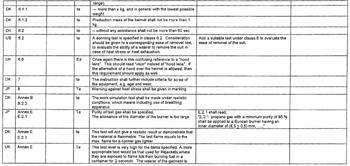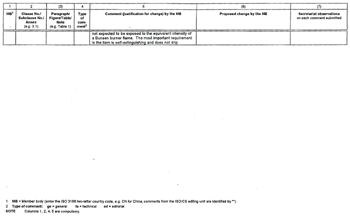| (拡大画面:160KB) |
 |
| (拡大画面:123KB) |
 |
| (拡大画面:52KB) |
 |
Proposed clause 5.5 is as follows:
5.5 Helmet
5.5.1 Requirements for helmet
5.5.1.1 Headform
A headform, constructed of hardwood or of any material with equivalent thermal conductivity and complying with a recognized national or international standard, shall be used.
5.5.1.2 Pre-treatment
5.5.1.2.1 Exposure to high temperature ambient
Boots shall be left in an atmosphere of 50 ± 2 ℃ for at least 2 hours.
5.5.1.2.2 Exposure to low temperature ambient
Boots shall be left in an atmosphere of -10 ± 2 ℃ for at least 2 hours.
5.5.1.2.3 Water immersion
Boots shall be left in water of 20 ± 2 ℃ for at least 4 hours.
5.5.1.2.4 Exposure to UV light
.1 Apparatus
A high pressure xenon 450 watt lamp with quartz easing, operated in accordance with the manufacturer's instructions. Means shall be provided to support the helmet so that it is exposed to the radiation.
.2 Procedure
Secure the helmet so that the vertical axis through the crown of the helmet (as worn) is perpendicular to the axis of the lamp and the distance between the crown of the helmet and the axis of the lamp is (150±5) mm.
Expose the helmet to the radiation for (400 ± 4) h. It shall then be removed and allowed to return to laboratory ambient conditions.
.3 Criteria
There shall be no damage or deterioration on the helmet.
5.5.1.3 Penetration test
.1 Principle
When a test striker falls on a safety helmet securely worn on a headform, the observation is made whether the striker touches the headform or whether there is a visible scar on the contactable surface of the headform.
.2 Apparatus
The base of the apparatus shall be monolithic and sufficiently large to offer full resistance to the effect of the blow.
A headform specified in 5.5.1.1 suitable for the size of test sample is securely mounted in a vertical position on the base surface.
The surface of the headform where the striker may contact shall be covered by a pressure sensitive film capable of directly detecting the contact of the striker.
The striker has the following characteristics (see Informative reference Fig. XX):
Mass: 3.0+0.05 kg
Angle of tip: 60±0.5 degree
Radius of tip: 0.5 ± 0.1 mm
Height of cone: approximately 40 mm
Hardness of tip: 45 HRC min.
The striker is positioned above the headform making the axis of striker coincide with the vertical axis of headform so as to be able to allow the striker to fall in either free fall or guided fall. When selecting guided fall, the retardation due to the guide shall be minimized.
.3 Test procedure
One sample shall be tested after each pre-treatment condition specified in 5.5.1.2. Following test shall be completed within 1 min after removal of the sample helmet from the temperature-conditioning chamber or water bath.
a) The sample shall be placed on the headform in the manner that the fitting means of helmet shall be adjusted to give largest space between the helmet and the headform.
b) The striker is allowed to fall on to the top of the helmet through a distance of (1000 ± 5) mm measured from the top of the helmet to the tip of the striker.
|